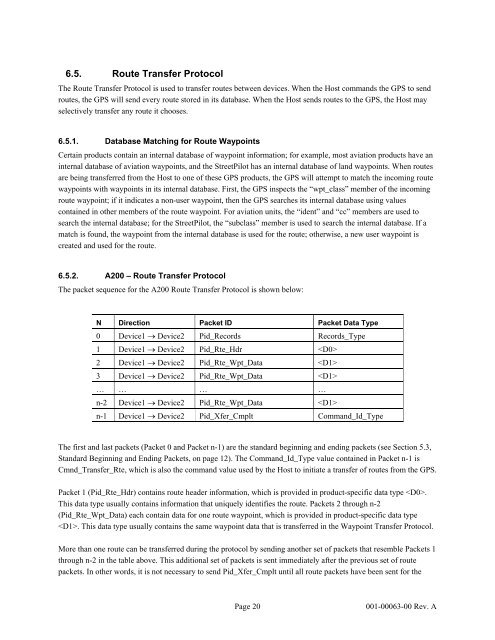GARMIN GPS Interface Specification
GARMIN GPS Interface Specification
GARMIN GPS Interface Specification
You also want an ePaper? Increase the reach of your titles
YUMPU automatically turns print PDFs into web optimized ePapers that Google loves.
6.5. Route Transfer Protocol<br />
The Route Transfer Protocol is used to transfer routes between devices. When the Host commands the <strong>GPS</strong> to send<br />
routes, the <strong>GPS</strong> will send every route stored in its database. When the Host sends routes to the <strong>GPS</strong>, the Host may<br />
selectively transfer any route it chooses.<br />
6.5.1. Database Matching for Route Waypoints<br />
Certain products contain an internal database of waypoint information; for example, most aviation products have an<br />
internal database of aviation waypoints, and the StreetPilot has an internal database of land waypoints. When routes<br />
are being transferred from the Host to one of these <strong>GPS</strong> products, the <strong>GPS</strong> will attempt to match the incoming route<br />
waypoints with waypoints in its internal database. First, the <strong>GPS</strong> inspects the “wpt_class” member of the incoming<br />
route waypoint; if it indicates a non-user waypoint, then the <strong>GPS</strong> searches its internal database using values<br />
contained in other members of the route waypoint. For aviation units, the “ident” and “cc” members are used to<br />
search the internal database; for the StreetPilot, the “subclass” member is used to search the internal database. If a<br />
match is found, the waypoint from the internal database is used for the route; otherwise, a new user waypoint is<br />
created and used for the route.<br />
6.5.2. A200 – Route Transfer Protocol<br />
The packet sequence for the A200 Route Transfer Protocol is shown below:<br />
N Direction Packet ID Packet Data Type<br />
0 Device1 → Device2 Pid_Records Records_Type<br />
1 Device1 → Device2 Pid_Rte_Hdr <br />
2 Device1 → Device2 Pid_Rte_Wpt_Data <br />
3 Device1 → Device2 Pid_Rte_Wpt_Data <br />
… … … …<br />
n-2 Device1 → Device2 Pid_Rte_Wpt_Data <br />
n-1 Device1 → Device2 Pid_Xfer_Cmplt Command_Id_Type<br />
The first and last packets (Packet 0 and Packet n-1) are the standard beginning and ending packets (see Section 5.3,<br />
Standard Beginning and Ending Packets, on page 12). The Command_Id_Type value contained in Packet n-1 is<br />
Cmnd_Transfer_Rte, which is also the command value used by the Host to initiate a transfer of routes from the <strong>GPS</strong>.<br />
Packet 1 (Pid_Rte_Hdr) contains route header information, which is provided in product-specific data type .<br />
This data type usually contains information that uniquely identifies the route. Packets 2 through n-2<br />
(Pid_Rte_Wpt_Data) each contain data for one route waypoint, which is provided in product-specific data type<br />
. This data type usually contains the same waypoint data that is transferred in the Waypoint Transfer Protocol.<br />
More than one route can be transferred during the protocol by sending another set of packets that resemble Packets 1<br />
through n-2 in the table above. This additional set of packets is sent immediately after the previous set of route<br />
packets. In other words, it is not necessary to send Pid_Xfer_Cmplt until all route packets have been sent for the<br />
Page 20 001-00063-00 Rev. A





